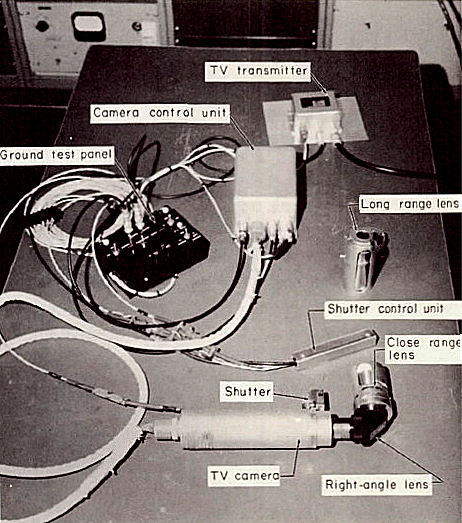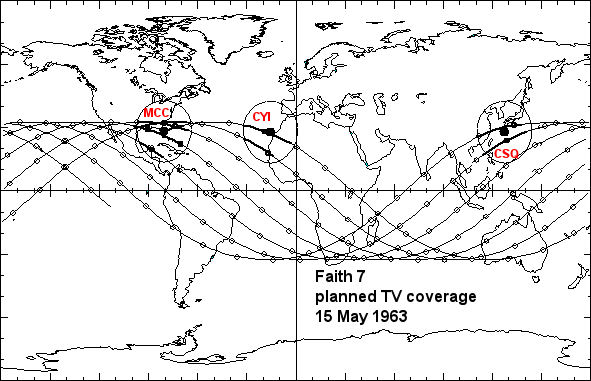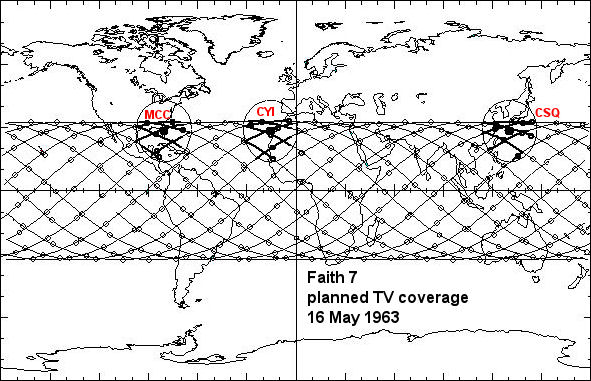 Gordon Cooper was launched from Cape Canaveral aboard the
last Mercury spacecraft, called Faith 7, at 1304.13 UT on 15 May
1963. He returned to Earth the following day at 2324.02 UT.
Gordon Cooper was launched from Cape Canaveral aboard the
last Mercury spacecraft, called Faith 7, at 1304.13 UT on 15 May
1963. He returned to Earth the following day at 2324.02 UT.
Sven Grahn
 Gordon Cooper was launched from Cape Canaveral aboard the
last Mercury spacecraft, called Faith 7, at 1304.13 UT on 15 May
1963. He returned to Earth the following day at 2324.02 UT.
Gordon Cooper was launched from Cape Canaveral aboard the
last Mercury spacecraft, called Faith 7, at 1304.13 UT on 15 May
1963. He returned to Earth the following day at 2324.02 UT.
A
slow-scan television system was included for evaluation aboard the Faith 7 spacecraft. However, the post-flight report states that "the quality and usefulness of its transmissions were not satisfactory". [1] The best picture available on-line is the image on the right which supposedly was transmitted on orbit 17 (remember the Mercury project numbered orbits so that the first orbit lasted from lift-off until the spacecraft passed the longutide of the Cape again. The passes over the ground station at the Cape took place during the time when the orbit number increased). The television system was fabricated by Lear Siegler Inc and delivered to NASA on March 19, 1963. The camera weighed 4.5 kg and consumed 56 W during operation. It was hand-held or bracket-mounted to the right of the three-axis controller. Cabling, bracket and other devices weighed an additional 3.2 kg. Two lenses were provided: a 1" lens with 26 degrees field of view and a 6" lens with a 4.8 degrees field of view. A
special telemetry transmitter was added to the spacecraft to transmit the TV
signal directly to the ground on the higher of the two standard telemetry
frequencies. This was probably the 246.3 MHz channel. TV
could only be obtained when the spacecraft was in telemetry contact with a
ground station to decode the TV. The scan rate was 0.5
frames/second.
Each frame had 320 lines.This scan rate required special equipment on the ground
to reconstruct the picture. The TV transmitter was frequency modulated with a
peak deviation of 125 kHz [2]
.
A
special telemetry transmitter was added to the spacecraft to transmit the TV
signal directly to the ground on the higher of the two standard telemetry
frequencies. This was probably the 246.3 MHz channel. TV
could only be obtained when the spacecraft was in telemetry contact with a
ground station to decode the TV. The scan rate was 0.5
frames/second.
Each frame had 320 lines.This scan rate required special equipment on the ground
to reconstruct the picture. The TV transmitter was frequency modulated with a
peak deviation of 125 kHz [2]
.
The Mercury Control Center (MCC), the Coastal Sentry Quebec (CSQ) tracking ship (located at 28.5 deg N, 130 deg E), and Grand Canary Island (CYI) were the only stations able to receive TV. At the Mercury Control Center the flight surgeon could see the pictures in real time as they were received every 2 seconds. There were five more monitors in the Mercury Control Center on which the images were shown as stills that changed every two seconds. 35 mm cameras were also used at Mercury Control Center to store the TV pictures. The plan was to have prints available in 15-20 minutes. At CSQ and CYI the TV signals were recorded on tape. CSQ also had a real-time display at the 0.5 frames/second rate.
The camera was controlled by a TV control switch with three positions "TV", "OFF", and "TM". The third position permitted telemetry normally transmitted on the lower frequency telemetry transmitter to be transmitted on the TV transmitter. This was a back-up telemetry mode. To conserve power the TV system was switched on only during the appropriate ground station passes. The picture on the left below can be found in [1], while the right-hand picture comes from [2].
 |
 |
The table below shows the planned TV transmission sessions in Ground Elapsed Time (hrs:min:sec) and the actual TV transmissions as evident from the air-to-ground voice transcripts. The question marks indicate that nothing was mentioned in the transcripts, but that does not mean that there was not a transmission at that particular time.
| Planned ON | Planned Off | Actual ON | Actual OFF | Station | Notes |
| 00:14:00 | 00:21:00 | ? | 00:22:58 | MCC | 1 st orbit |
| 01:34:00 | 01:40:00 | 01:34:08 | 01:40:22 | MCC | 1 st - 2 nd orbit |
| 01:48:00 | 01:54:00 | 01:48:35 | 01:50:26 | CYI | 2 nd orbit |
| 03:07:00 | 03:14:00 | 03:09:34 | 03:13:30 | MCC | 2 nd orbit |
| 04:41:00 | 04:47:00 | 04:40:32 | ? | MCC | 3 rd - 4 th orbit |
| 06:15:00 | 06:19:00 | 06:15:21 | 06:18:30 | MCC | 4 th - 5 th orbit |
| 08:48:00 | 08:55:00 | 08:52:31 | ? | CSQ | 6 th orbit |
| 10:22:00 | 10:28:00 | - | - | CSQ | 7 th orbit; TV probably not turned on |
| 11:55:00 | 12:02:00 | 11:56:00 | ? | CSQ | 8 th orbit |
| 13:29:00 | 13:36:00 | 13:33:38 | ? | CSQ | 9 th orbit; Bad signal |
| 15:02:00 | 15:08:00 | ? | ? | CSQ | 10 th orbit |
| 17:38:00 | 17:43:00 | ? | ? | CYI | 12 th orbit |
| 19:10:00 | 19:17:00 | ? | ? | CYI | 13 th orbit |
| 20:44:00 | 20:50:00 | ? | ? | CYI | 14 th orbit |
| 22:03:00 | 22:09:00 | 22:06:57 | 22:10:00 | MCC | 14 th - 15 th orbit; Good picture |
| 23:36:00 | 23:43:00 | 23:38:09 | 23:43:15 | MCC | 15 th - 16 th orbit |
| 25:10:00 | 25:16:00 | ? | ? | MCC | 16 th - 17 th orbit |
| 25:25:00 | 25:29:00 | 25:26:54 | 25:30:26 | CYI | 17 th orbit |
| 26:43:00 | 26:49:00 | ? | ? | MCC | 17 th - 18 th orbit |
| 28:16:00 | 28:23:00 | 28:17:12 | 28:20:14 | MCC | 18 th - 19 th orbit; Low light level |
| 29:51:00 | 29:54:00 | ? | ? | MCC | 19 th orbit |
| 30:53:00 | 30:54:00 | ? | ? | CSQ | 20 th orbit |
| 32:23:00 | 32:30:00 | ? | ? | CSQ | 21 st orbit |
| 33:57:00 | 34:03:00 | ? | ? | CSQ | 22 nd orbit |
The two maps below show the location of the the TV reception points and the passes over the horizon at those sites. The radio horizons are shown for zero degrees elevation angle.


|
|
|
|
|